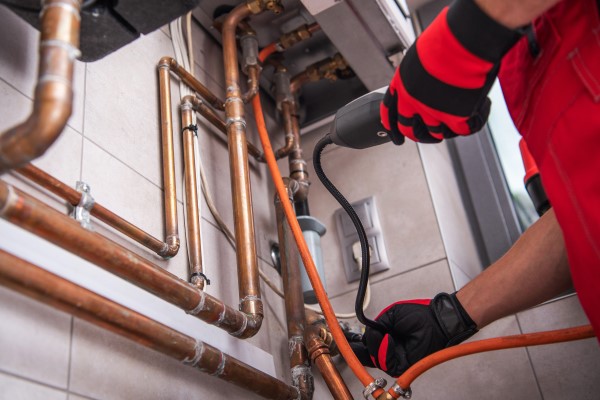How Furnace Efficiency Affects Your Fall Heating Costs: Repairing to Save Energy
Call Us Anytime!
Is Your Furnace Ready for Fall Weather?
As the fall season arrives and temperatures begin to drop, the use of your furnace becomes a necessity for maintaining a warm and comfortable home. However, as you turn up the heat, you might also notice an increase in your energy bills. One of the most effective ways to keep your heating costs in check is by ensuring your furnace is operating efficiently. A well-maintained and efficient furnace not only provides consistent comfort but can also lead to significant energy savings.
In this post, we will explore how furnace efficiency directly impacts your fall heating costs, the role of furnace repairs in improving efficiency, and practical tips to help you identify and address inefficiencies in your system.



The Link Between Furnace Efficiency and Heating Costs
Furnace efficiency refers to how effectively your furnace converts fuel into heat. This is measured by a unit’s Annual Fuel Utilization Efficiency (AFUE) rating, which represents the percentage of fuel that is converted into usable heat. For example, a furnace with an AFUE rating of 90% converts 90% of the fuel it consumes into heat, with the remaining 10% lost through exhaust or inefficiencies.
The higher the AFUE rating, the more efficient your furnace is, and the less energy it uses to heat your home. This directly impacts your heating costs: an inefficient furnace will require more energy to achieve the same level of warmth, leading to higher utility bills. Regular maintenance and timely repairs play a crucial role in maintaining and even improving your furnace’s efficiency, which helps reduce your fall heating costs.
Common Furnace Inefficiencies That Drive Up Energy Costs
Several factors can affect the efficiency of your furnace, leading to higher energy consumption and increased heating costs. Identifying these inefficiencies early on can save you money and prevent unnecessary wear and tear on your system. Below are some of the most common furnace inefficiencies:
- Dirty or Clogged Filters: When your furnace’s air filter is clogged with dust and debris, it restricts airflow, causing the furnace to work harder to circulate air through your home. This extra effort consumes more energy, reducing the furnace’s efficiency.
- Leaky Ductwork: If there are leaks or gaps in your home’s ductwork, a significant amount of warm air may escape before it reaches the living areas. This forces your furnace to run longer and use more energy to maintain the desired temperature.
- Poor Thermostat Calibration: A poorly calibrated thermostat may misread the temperature and cause your furnace to run more frequently than necessary. This leads to inefficient heating and higher energy bills.
- Worn Out Parts: Over time, components like the blower motor, burners, or heat exchanger may wear out or accumulate dirt, reducing their performance and efficiency.
- Pilot Light or Ignition Problems: In gas furnaces, issues with the pilot light or electronic ignition can prevent the furnace from running smoothly, leading to inefficient fuel consumption.
How Furnace Repairs Improve Efficiency and Lower Heating Costs
The good news is that many of the inefficiencies mentioned above can be addressed through regular maintenance and timely furnace repairs. Repairing faulty components and cleaning crucial parts of the system can restore your furnace’s efficiency and help reduce energy costs. Here’s how professional furnace repair can make a big difference:
- Fixing Leaky Ducts: One of the most significant inefficiencies in any heating system is air loss due to leaky ducts. A professional HVAC technician can inspect your ductwork and seal any leaks or gaps, ensuring that warm air reaches all the rooms in your home efficiently. Properly sealed ducts can improve airflow by up to 30%, reducing the workload on your furnace and saving energy.
- Replacing Worn-Out Parts: If your furnace’s blower motor, belts, or other parts are worn or damaged, they can cause the system to run inefficiently. Replacing or repairing these components will help the furnace operate more smoothly, using less energy to heat your home.
- Cleaning and Adjusting the Burner: The furnace’s burner is responsible for igniting the fuel and creating heat. Over time, dirt and soot can build up on the burner, reducing its efficiency. A professional technician can clean and adjust the burner to ensure it is burning fuel properly and efficiently.
- Calibrating the Thermostat: If your thermostat is causing your furnace to run longer than necessary, a technician can recalibrate it to ensure it reads the temperature accurately. A properly calibrated thermostat will help maintain a consistent temperature without overworking the furnace, saving you money in the long run.
- Fixing Ignition Issues: If your furnace has problems igniting, it may waste fuel trying to start up repeatedly. A technician can inspect and repair ignition problems, ensuring the furnace starts reliably and consumes fuel efficiently.
Tips for Identifying Furnace Inefficiencies
Before calling in a professional, there are a few signs and symptoms you can look for that may indicate your furnace is not operating at peak efficiency. Addressing these issues early can help you avoid higher energy bills and prevent more serious problems from developing:
- Rising Energy Bills: If you notice a sudden or unexplained increase in your energy bills during the fall, it could be a sign that your furnace is running inefficiently. This could be due to a number of factors, including clogged filters, worn-out parts, or leaky ductwork.
- Inconsistent Heating: If some rooms in your home are warmer than others or if the temperature fluctuates significantly, your furnace may be struggling to distribute heat evenly. This can be caused by duct leaks, thermostat issues, or an improperly sized furnace.
- Frequent Cycling: If your furnace is turning on and off frequently (short cycling), it may indicate an issue with the thermostat, airflow, or a malfunctioning component. Frequent cycling not only reduces efficiency but also places additional wear and tear on the system.
- Strange Noises: Unusual noises like banging, rattling, or squealing may indicate that parts of your furnace are worn or damaged. These noises often signal inefficiencies that can lead to higher energy consumption if left unaddressed.
- Age of the Furnace: If your furnace is more than 15-20 years old, it may be operating at a lower efficiency than newer models. Even with regular maintenance, older furnaces tend to become less efficient over time, leading to higher heating costs.
Professional Furnace Repair: Why It’s Worth the Investment
Investing in professional furnace repair services before the heating season can pay off significantly in energy savings. Here’s why professional repair is essential for maintaining an efficient furnace:
- Thorough Inspection: HVAC professionals conduct a comprehensive inspection of your furnace, identifying any areas that may be causing inefficiency. This ensures that all potential problems are addressed before they become major issues.
- Expert Diagnosis and Repair: HVAC technicians have the experience and knowledge to diagnose and repair any inefficiencies in your furnace. Whether it’s fixing a minor issue like a loose belt or addressing a more complex problem like a faulty heat exchanger, they can restore your furnace’s efficiency.
- Energy Savings: By ensuring your furnace is running efficiently, professional repairs can lead to lower energy consumption and reduced heating bills throughout the fall and winter seasons.
- Extended Furnace Lifespan: Regular repairs and maintenance help prevent major breakdowns and extend the overall lifespan of your furnace. This means you can avoid the expense of premature furnace replacement.
Additional Tips for Maximizing Furnace Efficiency This Fall
While professional repairs are essential for maintaining furnace efficiency, there are also a few steps you can take on your own to improve efficiency and lower heating costs:
- Change Your Air Filter Regularly: As mentioned earlier, a dirty air filter can significantly reduce your furnace’s efficiency. Be sure to replace your filter every 1 to 3 months during the heating season to maintain optimal airflow.
- Use a Programmable Thermostat: Set your thermostat to lower the temperature while you’re away or asleep to reduce energy consumption. Programmable thermostats can automatically adjust the temperature based on your schedule, helping you save energy without sacrificing comfort.
- Seal Windows and Doors: Prevent heat loss by sealing any gaps around windows and doors with weatherstripping or caulk. This keeps warm air inside and reduces the strain on your furnace.
- Install Insulation: Adding insulation to your home, particularly in the attic and walls, can help reduce heat loss and improve your furnace’s efficiency.
Let the Pros Keep Your Furnace Efficient
Furnace efficiency plays a significant role in determining your fall heating costs. By addressing inefficiencies such as dirty filters, leaky ducts, or worn-out parts, you can ensure that your furnace operates at peak efficiency, saving you energy and money. Investing in professional furnace repair services is essential for identifying and resolving these inefficiencies, helping you maintain a comfortable home throughout the heating season.
By following these tips and keeping your furnace in good condition, you’ll not only lower your energy bills but also extend the life of your heating system, making it a valuable long-term investment. As fall approaches, take the time to prepare your furnace for the colder months and enjoy the benefits of a more efficient, cost-effective heating system.


